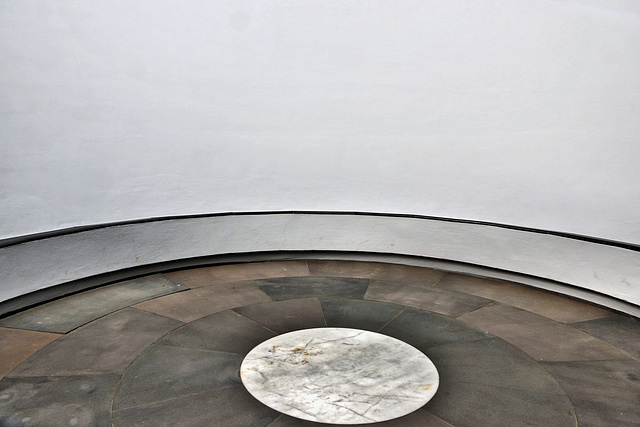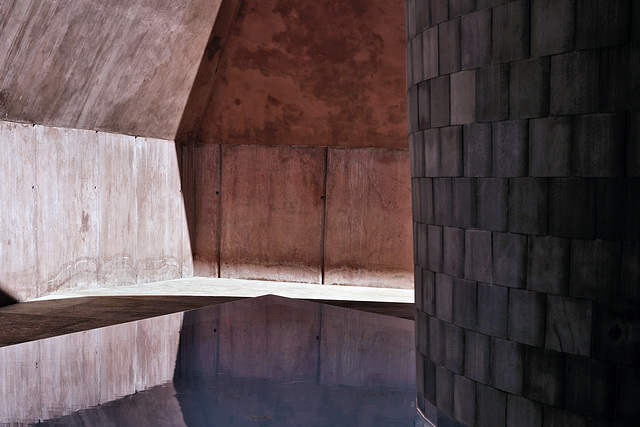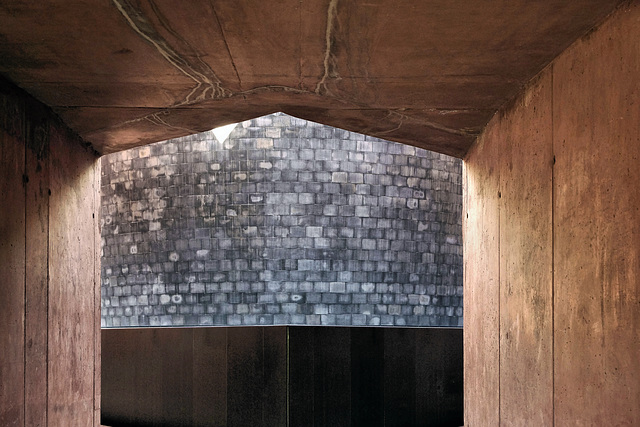Jonathan Cohen's photos
"Second Wind," Take #4 – Fundación NMAC, Vejer de la Frontera, Cádiz Province, Spain
James Turrell (born in Los Angeles, California in1943) is an artist who falls into the Land Art genre. The historical and artistic relevance of his work lies in his ability to examine the way in which we perceive light, and to isolate those features and present them to the viewer in each of his works. Instead of showing us the results of his research into the psychological perception of light, Turrell wants viewers to discover them for themselves, through their own experience. With his artworks, he offers us the chance to understand the various features of light and solar energy, and how the retina responds when faced with the changes in brightness and colour that take place throughout the day and in our planet’s two different hemispheres.
Second Wind 2005 is an architectural piece, located underground, in which viewers enter an inner pyramid, via a tunnel. Inside is a stone stupa, surrounded by a pool. Stupas are circular domes used in Buddhist architecture, and whose shape and position have the effect of making the cosmos appear closer. The passageway into the stupa leads to a room with a circular hole in the ceiling, open to the sky. Here, visitors can sit down and watch the changes of light "sculpted" by the artist. Turrell particularly recommends enjoying it at sunset, the moment of transition from day into night, when light is at its most intense and the colours of the sky are enhanced, altering the viewer’s perception of the sky as a space, a shape and an object.
The Fundación NMAC (the Montenmedio Arte Contemporáneo) is a unique space in Spain which explores the space shared by contemporary art and nature. The objective of the NMAC Foundation is to invite international artists to carry out specific artistic projects that are in tune with the landscape. NMAC is a cultural reference in southern Europe also for its educational and cultural programming.
"Second Wind," Take #3 – Fundación NMAC, Vejer de la Frontera, Cádiz Province, Spain
James Turrell (born in Los Angeles, California in1943) is an artist who falls into the Land Art genre. The historical and artistic relevance of his work lies in his ability to examine the way in which we perceive light, and to isolate those features and present them to the viewer in each of his works. Instead of showing us the results of his research into the psychological perception of light, Turrell wants viewers to discover them for themselves, through their own experience. With his artworks, he offers us the chance to understand the various features of light and solar energy, and how the retina responds when faced with the changes in brightness and colour that take place throughout the day and in our planet’s two different hemispheres.
Second Wind 2005 is an architectural piece, located underground, in which viewers enter an inner pyramid, via a tunnel. Inside is a stone stupa, surrounded by a pool. Stupas are circular domes used in Buddhist architecture, and whose shape and position have the effect of making the cosmos appear closer. The passageway into the stupa leads to a room with a circular hole in the ceiling, open to the sky. Here, visitors can sit down and watch the changes of light "sculpted" by the artist. Turrell particularly recommends enjoying it at sunset, the moment of transition from day into night, when light is at its most intense and the colours of the sky are enhanced, altering the viewer’s perception of the sky as a space, a shape and an object.
The Fundación NMAC (the Montenmedio Arte Contemporáneo) is a unique space in Spain which explores the space shared by contemporary art and nature. The objective of the NMAC Foundation is to invite international artists to carry out specific artistic projects that are in tune with the landscape. NMAC is a cultural reference in southern Europe also for its educational and cultural programming.
"Second Wind," Take #2 – Fundación NMAC, Vejer de la Frontera, Cádiz Province, Spain
James Turrell (born in Los Angeles, California in1943) is an artist who falls into the Land Art genre. The historical and artistic relevance of his work lies in his ability to examine the way in which we perceive light, and to isolate those features and present them to the viewer in each of his works. Instead of showing us the results of his research into the psychological perception of light, Turrell wants viewers to discover them for themselves, through their own experience. With his artworks, he offers us the chance to understand the various features of light and solar energy, and how the retina responds when faced with the changes in brightness and colour that take place throughout the day and in our planet’s two different hemispheres.
Second Wind 2005 is an architectural piece, located underground, in which viewers enter an inner pyramid, via a tunnel. Inside is a stone stupa, surrounded by a pool. Stupas are circular domes used in Buddhist architecture, and whose shape and position have the effect of making the cosmos appear closer. The passageway into the stupa leads to a room with a circular hole in the ceiling, open to the sky. Here, visitors can sit down and watch the changes of light "sculpted" by the artist. Turrell particularly recommends enjoying it at sunset, the moment of transition from day into night, when light is at its most intense and the colours of the sky are enhanced, altering the viewer’s perception of the sky as a space, a shape and an object.
The Fundación NMAC (the Montenmedio Arte Contemporáneo) is a unique space in Spain which explores the space shared by contemporary art and nature. The objective of the NMAC Foundation is to invite international artists to carry out specific artistic projects that are in tune with the landscape. NMAC is a cultural reference in southern Europe also for its educational and cultural programming.
"Second Wind, Take #1," – Fundación NMAC, Vejer de la Frontera, Cádiz Province, Spain
James Turrell (born in Los Angeles, California in1943) is an artist who falls into the Land Art genre. The historical and artistic relevance of his work lies in his ability to examine the way in which we perceive light, and to isolate those features and present them to the viewer in each of his works. Instead of showing us the results of his research into the psychological perception of light, Turrell wants viewers to discover them for themselves, through their own experience. With his artworks, he offers us the chance to understand the various features of light and solar energy, and how the retina responds when faced with the changes in brightness and colour that take place throughout the day and in our planet’s two different hemispheres.
Second Wind 2005 is an architectural piece, located underground, in which viewers enter an inner pyramid, via a tunnel. Inside is a stone stupa, surrounded by a pool. Stupas are circular domes used in Buddhist architecture, and whose shape and position have the effect of making the cosmos appear closer. The passageway into the stupa leads to a room with a circular hole in the ceiling, open to the sky. Here, visitors can sit down and watch the changes of light "sculpted" by the artist. Turrell particularly recommends enjoying it at sunset, the moment of transition from day into night, when light is at its most intense and the colours of the sky are enhanced, altering the viewer’s perception of the sky as a space, a shape and an object.
The Fundación NMAC (the Montenmedio Arte Contemporáneo) is a unique space in Spain which explores the space shared by contemporary art and nature. The objective of the NMAC Foundation is to invite international artists to carry out specific artistic projects that are in tune with the landscape. NMAC is a cultural reference in southern Europe also for its educational and cultural programming.
"Puente," Take #2 – Fundación NMAC, Vejer de la Frontera, Cádiz Province, Spain
Shen Yuan was born in Xianyou, China in 1959. At then end of the 1980’s she emigrated to the west. She currently lives and works in Paris.
Ceramic, the essential material used in her work Bridge, for the NMAC Foundation in 2004, providing the vehicle for a union between very distant cultures, one the one hand the Chinese culture, from which the artist originates and on the other, the Spanish culture with its Islamic reminiscences, as a reflection of the past. It is a ceramic bridge derived from an oval handrail and a walkway which has no concrete end. The balustrade is comprised of two identical rows of decorated vases with Chinese and Islamic motifs. Furthermore the ends of the bridge are decorated with two slender ceramic structures with the same decorative motifs.
"Bridge" represents a metaphor for the difficulties which must be overcome by different cultures, before one can obtain an influence over the other, as on occasion language, traditions and customs can become serious impediments to multicultural coexistence. This work symbolises the cultural syncretism reflected in the ceramics (Chinese and Arabic designs) and the obstacles imposed by the cultural differences which at times impede understanding between mankind.
The Fundación NMAC (the Montenmedio Arte Contemporáneo) is a unique space in Spain which explores the space shared by contemporary art and nature. The objective of the NMAC Foundation is to invite international artists to carry out specific artistic projects that are in tune with the landscape. NMAC is a cultural reference in southern Europe also for its educational and cultural programming.
"Puente," Take #1 – Fundación NMAC, Vejer de la Frontera, Cádiz Province, Spain
Shen Yuan was born in Xianyou, China in 1959. At then end of the 1980’s she emigrated to the west. She currently lives and works in Paris.
Ceramic, the essential material used in her work Bridge, for the NMAC Foundation in 2004, providing the vehicle for a union between very distant cultures, one the one hand the Chinese culture, from which the artist originates and on the other, the Spanish culture with its Islamic reminiscences, as a reflection of the past. It is a ceramic bridge derived from an oval handrail and a walkway which has no concrete end. The balustrade is comprised of two identical rows of decorated vases with Chinese and Islamic motifs. Furthermore the ends of the bridge are decorated with two slender ceramic structures with the same decorative motifs.
"Bridge" represents a metaphor for the difficulties which must be overcome by different cultures, before one can obtain an influence over the other, as on occasion language, traditions and customs can become serious impediments to multicultural coexistence. This work symbolises the cultural syncretism reflected in the ceramics (Chinese and Arabic designs) and the obstacles imposed by the cultural differences which at times impede understanding between mankind.
The Fundación NMAC (the Montenmedio Arte Contemporáneo) is a unique space in Spain which explores the space shared by contemporary art and nature. The objective of the NMAC Foundation is to invite international artists to carry out specific artistic projects that are in tune with the landscape. NMAC is a cultural reference in southern Europe also for its educational and cultural programming.
"Plansone Duty Free Project," Take #2 – Fundación NMAC, Vejer de la Frontera, Cádiz Province, Spain
Pascale Marthine Tayou is a Cameroonian artist born in Yaounde, Cameroon in 1967. He began his career as an artist in the 1990’s, and has carried out exhibitions in Cameroon, Germany, France, and Belgium, among others. Formerly known as Pascal Marthin Tayou, he changed his name to Pascale Marthine Tayou in the 1990’s.
Tayou’s work combines various media and seeks to artistically redefine postcolonial culture and raise questions about globalization and modernity. The objects, installations, sculptures, videos, photography and publications that constitute his works are formed by objects from daily life, that have normally already been used, abandoned and rejected by society. When recycling these objects, Pascale Marthine Tayou gives the objects a new life with the aim of reversing the degradation process. He refers to his projects as "collective works," like a total summary of his journeys and the findings and experiences derived from them. "I leave others the possibility to comment. In my opinion art is simply a form of communication."
The Fundación NMAC (the Montenmedio Arte Contemporáneo) is a unique space in Spain which explores the space shared by contemporary art and nature. The objective of the NMAC Foundation is to invite international artists to carry out specific artistic projects that are in tune with the landscape. NMAC is a cultural reference in southern Europe also for its educational and cultural programming.
"Plansone Duty Free Project," Take #1 – Fundación NMAC, Vejer de la Frontera, Cádiz Province, Spain
Pascale Marthine Tayou is a Cameroonian artist born in Yaounde, Cameroon in 1967. He began his career as an artist in the 1990’s, and has carried out exhibitions in Cameroon, Germany, France, and Belgium, among others. Formerly known as Pascal Marthin Tayou, he changed his name to Pascale Marthine Tayou in the 1990’s.
Tayou’s work combines various media and seeks to artistically redefine postcolonial culture and raise questions about globalization and modernity. The objects, installations, sculptures, videos, photography and publications that constitute his works are formed by objects from daily life, that have normally already been used, abandoned and rejected by society. When recycling these objects, Pascale Marthine Tayou gives the objects a new life with the aim of reversing the degradation process. He refers to his projects as "collective works," like a total summary of his journeys and the findings and experiences derived from them. "I leave others the possibility to comment. In my opinion art is simply a form of communication."
The Fundación NMAC (the Montenmedio Arte Contemporáneo) is a unique space in Spain which explores the space shared by contemporary art and nature. The objective of the NMAC Foundation is to invite international artists to carry out specific artistic projects that are in tune with the landscape. NMAC is a cultural reference in southern Europe also for its educational and cultural programming.
"Quasi Brick Wall" – Fundación NMAC, Vejer de la Frontera, Cádiz Province, Spain
"Quasi Brick Wall" is the work of Olafur Eliasson. a Danish-Icelandic artist known for sculptures and large-scale installation art employing elemental materials such as light, water, and air temperature to enhance the viewer’s experience..
From the outset, the artist’s creative interests were focused on the study of sensory perception, the laws of physics and natural conditions. The basic elements of time: water, light, temperature and pressure are the materials that the artist has used throughout his career, introducing natural phenomen in unexpected places. This is also the case in his work undertaken for the NMAC Foundation, where he toys with the perception of the surroundings through light and materialisation.
Through study and research of various mathematic formulae, the artist has invented a geometric figure in the shape of a dodecahedron, which complies with the functions of the "almost perfect" geometric model, constructed in baked clay bricks. With this new type of brick a curved wall was built with the concave side exposed to the light. The bricks, positioned in a random fashion, form a rough, unequal surface in which he has hung several mirrors which reflect sunrays, creating a curtain of light particles which can be made out from different areas of the wood attracting the public’s eye.
Light is a fundamental element in the area where the institution is located, acting as a constant which defines the history, culture and life of the area. Through it, this wall achieves an interactive encounter between the subject and object. As with the rest of his works, the physical spaces that surround us and the external elements form part of the majority these spaces, in the form of devices which activate the work in the presence of the public.
The Fundación NMAC (the Montenmedio Arte Contemporáneo) is a unique space in Spain which explores the space shared by contemporary art and nature. The objective of the NMAC Foundation is to invite international artists to carry out specific artistic projects that are in tune with the landscape. NMAC is a cultural reference in southern Europe also for its educational and cultural programming.
Jump to top
- ipernity © 2007-2025
- Help & Contact
|
Club news
|
About ipernity
|
History |
ipernity Club & Prices |
Guide of good conduct
Donate | Group guidelines | Privacy policy | Terms of use | Statutes | In memoria -
Facebook
Twitter










